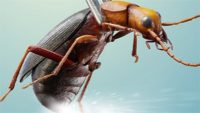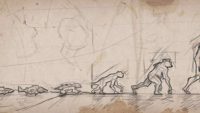How do you know when something has been engineered? One way to tell is to study the words used to describe its characteristic features. The Mt. Rushmore rock faces have different characteristics from the surrounding uncarved rock that don’t resemble portraits of American Presidents. Good scientific theories should be able to make predictions—including ones intended to explain biological phenomena. ICR previously… More… …read more Source: icr.org
Not a problem for the biblical timescale. …read more Source: creation.com
Deactivation of genes coding for limb morphology and loss of limbs is yet another case of devolution, not evolution. …read more Source: creation.com
Bonnethead sharks have short ‘carnivorous ancestry’ intestines, yet their stomachs have been found to contain up to 62% seagrass …read more Source: creation.com
By Harry F. Sanders, III Top stories of 2019 in biology: Plant communication, Human Y chromosome molecular clock, and remembering popular AiG speaker, Dr. Tommy Mitchell. …read more Source: AIG Daily
By Dr. Andrew A. Snelling How could neat uniform sedimentary rock layers be deposited during the Flood cataclysm with all the fast-moving waters? …read more Source: AIG Daily
By Dr. Danny R. Faulkner What’s happening in the night sky with Venus, Mercury, Mars, Jupiter, Saturn, and the Perseid Meteor Shower in 2020. …read more Source: AIG Daily
Does the supposed ‘flat earth/solid sky’ cosmology of the ancients mean we can read the Genesis 1 days non-literally? …read more Source: creation.com
By Dr. Danny R. Faulkner Betelgeuse, the 2nd brightest star in Orion, is one of the brightest stars in our sky. Some reports suggest it’s becoming a supernova—which is doubtable. …read more Source: AIG Daily
A new review paper published in the journal Expert Review of Proteomics summarizes 85 reports of organic remains in fossils.1 Some of the reports describe whole tissues like blood vessels, dried but intact skin, and connective tissues on or inside fossils like dinosaur bones. Other reports describe whole cells like red blood cells and bone cells. Other reports in the review paper describe biochemicals specific to animals… More… …read more Source: icr.org
By Troy Lacey The biggest stories in 2019 in geology and paleontology: includes how diamonds can take weeks to form in a lab, fossilized insects in gemstones, mass extinctions, and more. …read more Source: AIG Daily
A crayfish that reproduces asexually raises some important questions regarding the origins of sex. …read more Source: creation.com
By Melissa Webb When Dr. Andy McIntosh investigated the bombardier beetle, he discovered explosive evidence of God’s intricate design. …read more Source: AIG Daily
By Dr. David Menton Transitional forms in the fossil record are rarely, if ever, observed. This lack of evidence is very damaging to macroevolutionary theory. …read more Source: AIG Daily
By Ken Ham What is evolution? Well, that really depends on whom you ask. There are all kinds of definitions out there. Typically, when we think of evolution, we think of Darwinian evolution—the idea of all life descended from a common ancestor as one kind turns into another kind, and eventually ape-like creatures supposedly evolved into humans. But now we often hear a very different definition: those small changes within a kind are, well, evolution! A recent article defined evolution according to a definition from famous evolutionary biologist, Richard Dawkins: “evolution is changed gene frequencies in populations.” The article goes [More]
Echinoderms, “spiny-skinned” invertebrates, are first found in the Cambrian sedimentary rock layers as 100% echinoderms. The first brittle stars (Echinoderm, class Ophiuroidea) were found in the Early Ordovician sediments and don’t show any evolution. One of the more interesting of the Ophiuroidea is the brittle star (Ophiocoma wendtii). While snorkeling the waters of Hawaii several years ago, I f… More… …read more Source: icr.org
By Ken Ham Sometimes you just have to shake your head. That was my reaction when I read this headline, “Zoo Chimps Doing a ‘Conga Line’ Could Teach Us How Humans Evolved to Dance.” Yes, you read that right! Two chimps swaying and walking in synchronization is thought by these researchers to provide insight into the evolution of dance. These particular chimps were very closely bonded, having been together since they were just a few months old (one of the chimps died in 2018). For several years, they exhibited this strange, apparently self-taught behavior, of walking and swaying in sync. [More]
It doesn’t fit any evolutionary story. …read more Source: creation.com
Based on biblical chronologies, we can determine that the global Flood recorded in Genesis occurred about 4,500 years ago.1 After the Flood, the earth was repopulated by Noah’s three sons and their wives. So we should find genetic signatures of this timeline in human DNA. While a number of previous studies by both secular and creation scientists have supported this general timeline,2-3 a recent study using extens… More… …read more Source: icr.org
By Bodie Hodge Exploring the history of the water vapor canopy model, biblical interpretation surrounding the model, and how we should approach theories in biblical creation. …read more Source: AIG Daily
Scientists have reported the presence of methane-producing microbes living deep beneath the Siljan impact crater in Sweden.1 Although the researchers stopped short of claiming the impact somehow brought the microbes to Earth, they do assert that impacts can create favorable habitats for colonization. The 30-mile wide Siljan impact site is ringed by Ordovician and Silurian sediments, including black shales that ap… More… …read more Source: icr.org
By Ken Ham What exactly is it? That’s the question researchers are trying to figure out after the discovery of a frozen puppy preserved in permafrost in eastern Siberia. The two-month old canine was “remarkably preserved,” with fur, nose, and teeth still intact, even after a supposed 18,000 years. According to the BBC, scientists are wondering if this puppy represents an evolutionary link between wolves and dogs, or if it’s just a wolf or what we call a dog today. Researchers sequenced the puppy’s DNA but were unable to determine whether it was a wolf or a dog. This suggests [More]
When wading into the waters of apologetics and the origins debate, it usually doesn’t take long before we hit problems defining terms. Many words commonly used in these debates have large ranges of meaning that often get conflated and confused with each other. If we are to have a meaningful dialogue, we must be careful to define our terms carefully so that everyone understands each other. Read More: Defining terms carefully – creation.com
By Troy Lacey It can seem contradictory when we look at ancient Egyptian art that often shows remarkable stability in appearance to today’s cats. …read more Source: AIG Daily
It’s exciting when research with medical implications also provides insight into the mechanisms of biological adaptation. Two new studies contribute to a large body of research that not only contradicts the textbook account for the evolution of life on Earth, but also supports the explanation of engineered adaptability. By way of background, the standard account of evolution is a two-step process that supposedly explains how … More… …read more Source: icr.org
By Dr. John H. Whitmore “Living fossils” are organisms that can be found both living in the world today and also found preserved in the rock record as fossils. …read more Source: AIG Daily
How did Neanderthals go extinct? Four researchers from the Netherlands recently published the results of their computer-modeled human populations in the journal PLOS ONE.1 The findings show that small Neanderthal population sizes would have caused them to become extinct in just 10,000 years. How did Neanderthals survive the 400,000 years they were supposedly on Earth? Neanderthals were real people. Hundreds of r… More… …read more Source: icr.org

















![Bill & Gloria Gaither – Only a Look [Live] ft. Lillie Knauls Bill & Gloria Gaither – Only a Look [Live] ft. Lillie Knauls](http://img.youtube.com/vi/S26pab94jao/0.jpg)



























